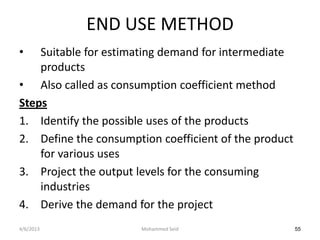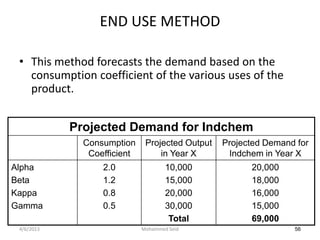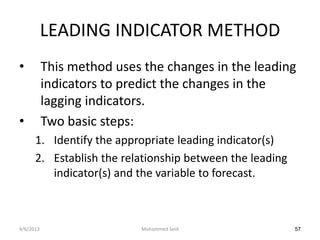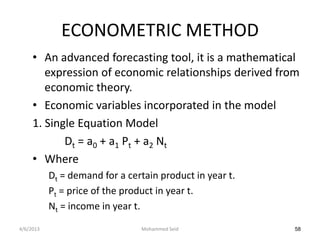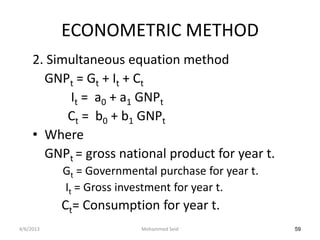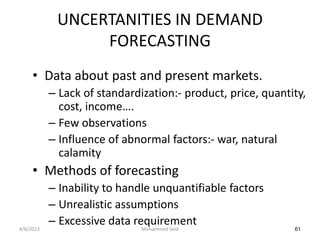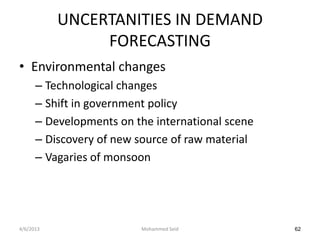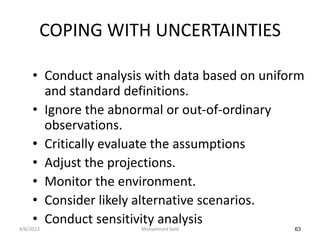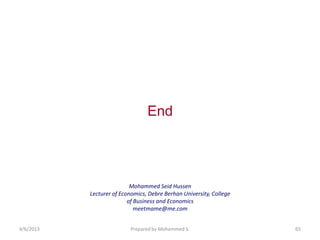Aspect of development project prepation
- 1. Chapter 2: Aspects of project preparation and analysis Mohammed seid Hussen Lecturer of Economics Debre Berhan University College of Business and Economics meetmame@me.com March, 2013
- 2. Forestry Wind power Hydro power Heavy Industry Bio-fuels Transport Animal waste Sewage / Landfill wastewater Bagasse 4/6/2013 Prepared by Mohammed S. 2
- 3. 2.1. Demand and market analysis ÔÇó is to identify the needs of the consumers and determine whether they are willing and have the capability to pay for a given product. ÔÇó should be carried out for the following main reasons: ÔÇô whether the goods and services required by the community ÔÇô to estimate the volume which it would wish to acquire at given prices 4/6/2013 by Mohammed S. 3
- 4. ÔÇó market study should include ´â╝determination of potential demand for the projectÔÇÖs output and the volume at given price range ´â╝target group ´â╝time frame for the demand ÔÇó relevant both to projects which produce ÔÇô marketableÔÇØ goods and services ÔÇô social goods and are supplied ÔÇÿfreeÔÇÖ which do not, such as schools, hospitals, roads and the like 4/6/2013 by Mohammed S. 4
- 5. ÔÇó Market analysis is basically concerned with the following questions ÔÇô What is the product/service to for which feasibility study is to be undertaken? ÔÇó What is the specific need which is the basis for the product/service? ÔÇó Are there alternative ways of satisfying the need? ÔÇô What would be the aggregate demand of the proposed product/service in future? ÔÇô What would be the market share of the project under appraisal? 4/6/2013 by Mohammed S. 5
- 6. ÔÇô What is the ongoing and competitive selling price? ÔÇô Will the realization of the project affect the selling price(s) of the products/services? ÔÇô What are the marketing strategies that enable the firm to enter into a market and capture adequate market size? 4/6/2013 by Mohammed S. 6
- 7. Saying on perspectives on effective demand and market promotion A saying goes, ÔÇ£an economist and marketer were sent to make market study for shoes in an island. Immediately after their arrival, they observed that the people there were all barefoot. Both had to write independent reports. The economist reported that there is no market because there is no revealed demand for shoes as the entire population is barefoot. The market reported that there is big, untapped market, no has not entered into the market and hence he appreciated the possibility of taking the entire market. But he/she qualified the fact that there is a need for promotional work.ÔÇØ 4/6/2013 by Mohammed S. 7
- 8. ÔÇó To answer the above questions the project analyst requires information ÔÇô Consumption trends in the past and the present consumption levels ÔÇô Past and present supply positions ÔÇô Production possibilities and constraints ÔÇô Imports and exports ÔÇô Cost structure ÔÇô Elasticity of demand ÔÇô Consumer behavior, intentions, attitudes, preferences, and requirements 4/6/2013 by Mohammed S. 8
- 9. ÔÇó it should be carried out in an orderly and systematic manner ÔÇô Situational analysis and specification of objectives ÔÇô Collection of secondary information ÔÇô Conduct of market survey ÔÇô Characterization of the market ÔÇô Demand forecasting ÔÇô Market planning 4/6/2013 by Mohammed S. 9
- 10. 2.2 situational analysis and specification of the objectives ÔÇó the project analyst may talk to consumers, competitors, middlemen, and other in the industry ÔÇó also look at the preferences and purchasing power of consumerÔÇÖs, actions and strategies of competitors and practices of the middlemen/distributors, whole sellers and retailers/. 4/6/2013 by Mohammed S. 10
- 11. Key steps in market and demand analysis and their inter-relationships Collection of Demand Secondary Forecasting Information Situational Characterization Analysis and of the Market Specifications of Objectives Conduct of Market Market Survey Planning 4/6/2013 Mohammed Seid 11
- 12. Example: suppose a given project aims at producing wheat in a given locality. The project initiator and implementer need information about where and how to market their product. The objective of the market and demand analysis in this case may be to answer some of the following questions. ÔÇô Who are the buyers of this product ÔÇô What is the total current demand for wheat? ÔÇô How is the demand distributed temporally /pattern of sale over the year and geographically? ÔÇô What price will the consumers be willing to pay for the product? ÔÇô How can consumers be convinced that wheat could be substituted for other foodstuffs? ÔÇô What channels of distributions are most suited for the product? ÔÇô What trade margins will induce distributors to carry it out? ÔÇô What are the possible immediate sales? 4/6/2013 by Mohammed S. 12
- 13. 2.3 method of data collection ÔÇó two principal sources of assembling market information ÔÇô Secondary data sources; ÔÇô Primary data sources. 4/6/2013 by Mohammed S. 13
- 14. Òàü. Indirect (Secondary) Sources -documents -statistics -key informant approach Òàü. Direct ( primary) Sources -interview -focus group discussions -questionnaires or surveys -direct observation
- 15. SEVEN DATA COLLECTION TECHNIQUES FOR DEVELOPMENT PROJECT NEEDS ASSESSMENT Secondary sources Method Definition Sources Advantages Disadvantages Documentary Systematic Libraries; Already collected; Not always available Research reading of Scholars; Low level of effort on topics needed; needs data Officials; to analyze. Can be dated; usually compiled by Specialized incomplete. secondary sources agencies Statistics and Sorting and Ministry data Available in most May contain gaps; Planning analyzing bases; line ministries; usually unaggregated; Data information from Planning easy to obtain; Requires a specialist extant data departments; Can be to analyze it. bases Statistics voluminous centres Key Interviewing of People or Economical; relies Informants may inject Information knowledgeable agencies on knowledgeable their own biases. Approach secondary which are in a informants. sources position to know about the subjects
- 16. SEVEN DATA COLLECTION TECHNIQUES FOR DEVELOPMENT PROJECT NEEDS ASSESSMENT Primary sources Method Definition Sources Advantages Disadvantages Interview Soliciting and Primary Goes right to the Can be expensive; Recording sources like source of the requires some special Information project information. interviewing skills. By asking beneficiaries Questions Focus Group Small Group Primary Introduces Somewhat of an discussion sources like element of artificial setting for focuses on project spontaneity since such a discussion development beneficiaries discussion is un- may inhibit some. Problems. guided. Questionnaire Published list of Primary or When well done, it Difficult to construct; questions to be secondary obtains highly Requires high degree answered by sources reliable data. of skill. every informant. Direct Firsthand Primary Lacks artificiality of Can be expensive if Observation exposure of the sources like other methods; lots of exposure is project team to project Gives assessor required; difficult to the behaviour or beneficiaries standardize data. good exposure. phenomenon being assessed.
- 17. Forecasting ÔÇó Predicting the future ÔÇó Qualitative forecast methods ÔÇô subjective ÔÇó Quantitative forecast methods ÔÇô based on mathematical formulas 4/6/2013 Mohammed Seid 17 ´üÀ12-17
- 18. Types of Forecasting Methods ÔÇó Depend on ÔÇô time frame ÔÇô demand behavior ÔÇô causes of behavior 4/6/2013 Mohammed Seid 18 ´üÀ12-18
- 19. Time Frame ÔÇó Indicates how far into the future is forecast ÔÇô Short- to mid-range forecast ÔÇó typically encompasses the immediate future ÔÇó daily up to two years ÔÇô Long-range forecast ÔÇó usually encompasses a period of time longer than two years 4/6/2013 Mohammed Seid 19 ´üÀ12-19
- 20. Demand Behavior ÔÇó Trend ÔÇô a gradual, long-term up or down movement of demand ÔÇó Random variations ÔÇô movements in demand that do not follow a pattern ÔÇó Cycle ÔÇô an up-and-down repetitive movement in demand ÔÇó Seasonal pattern ÔÇô an up-and-down repetitive movement in demand occurring periodically 4/6/2013 Mohammed Seid 20 ´üÀ12-20
- 21. Causes of Behavior ÔÇó Analytical ÔÇó Cause effect relationship basis ÔÇó Quantitative ÔÇó Explicit 4/6/2013 Mohammed Seid 21
- 22. DEMAND FORECASTING ÔÇó Qualitative Methods ÔÇô These methods rely essentially on the judgment of experts to translate qualitative information into quantitative estimates ÔÇô Used to generate forecasts if historical data are not available (e.g., introduction of new product) ÔÇô The important qualitative methods are: ÔÇó Jury of Executive Method ÔÇó Delphi Method 4/6/2013 Mohammed Seid 22
- 23. JURY OF EXECUTIVE OPINION METHOD ÔÇó Rationale ÔÇô Upper-level management has best information on latest product developments and future product launches ÔÇó Approach ÔÇô Small group of upper-level managers collectively develop forecasts ÔÇô Opinion of Group ÔÇó Main advantages ÔÇô Combine knowledge and expertise from various functional areas ÔÇô People who have best information on future developments generate the forecasts 4/6/2013 Mohammed Seid 23
- 24. JURY OF EXECUTIVE OPINION METHOD ÔÇó Main drawbacks ÔÇô Expensive ÔÇô No individual responsibility for forecast quality ÔÇô Risk that few people dominate the group ÔÇô Subjective ÔÇô Reliability is questionable ÔÇó Typical applications ÔÇô Short-term and medium-term demand forecasting 4/6/2013 Mohammed Seid 24
- 25. DELPHI METHOD ÔÇó Rationale ÔÇô Eliciting the opinions of a group of experts with the help of mail survey ÔÇô Anonymous written responses encourage honesty and avoid that a group of experts are dominated by only a few members 4/6/2013 Mohammed Seid 25
- 26. DELPHI METHOD ÔÇó Approach Coordinator Each expert Coordinator Sends Initial writes response performs Questionnaire (anonymous) analysis Coordinator No Coordinator sends updated Consensus Yes summarizes questionnaire reached? forecast 4/6/2013 Mohammed Seid 26
- 27. DELPHI METHOD ÔÇó Main advantages ÔÇô Generate consensus ÔÇô Can forecast long-term trend without availability of historical data ÔÇó Main drawbacks ÔÇô Slow process ÔÇô Experts are not accountable for their responses ÔÇô Little evidence that reliable long-term forecasts can be generated with Delphi or other methods 4/6/2013 Mohammed Seid 27
- 28. DELPHI METHOD ÔÇó Typical application ÔÇô Long-term forecasting ÔÇô Technology forecasting 4/6/2013 Mohammed Seid 28
- 29. TIME SERIES PROJECTION METHODS ÔÇó These methods generate forecasts on the basis of an analysis of the historical time series. ÔÇó Assume that what has occurred in the past will continue to occur in the future ÔÇó Relate the forecast to only one factor - time The important time series projection methods are: ÔÇô Trend Projection Method ÔÇô Exponential Smoothing Method ÔÇô Moving Average Method 4/6/2013 Mohammed Seid 29
- 30. Linear Trend Line xy - nxy y = a + bx b = x2 - nx2 a = y-bx where a = intercept of the where relationship n = number of periods b = slope of the line x = time period x x = = mean of the x values y = forecast for n demand for period x y y = n = mean of the y values 4/6/2013 Mohammed Seid 30 ´üÀ12-30
- 31. Least Squares Example x(PERIOD) y(DEMAND) xy x2 1 73 73 1 2 40 80 4 3 41 123 9 4 37 148 16 5 45 225 25 6 50 300 36 7 43 301 49 8 47 376 64 9 56 504 81 10 52 520 100 11 55 605 121 12 54 648 144 78 557 3867 650 4/6/2013 Mohammed Seid 31 ´üÀ12-31
- 32. Least Squares Example (cont.) 78 x = = 6.5 12 557 y = = 46.42 12 xy - nxy 3867 - (12)(6.5)(46.42) b = 2 - nx2 = =1.72 x 650 - 12(6.5)2 a = y - bx = 46.42 - (1.72)(6.5) = 35.2 4/6/2013 Mohammed Seid 32 ´üÀ12-32
- 33. Linear trend line y = 35.2 + 1.72x Forecast for period 13 y = 35.2 + 1.72(13) = 57.56 units 70 ÔÇô 60 ÔÇô Actual 50 ÔÇô Demand 40 ÔÇô Linear trend line 30 ÔÇô 20 ÔÇô 10 ÔÇô | | | | | | | | | | | | | 1 2 3 4 5 6 7 8 9 10 11 12 13 0ÔÇô Period 4/6/2013 Mohammed Seid 33 ´üÀ12-33
- 34. Trend Projection Method Advantages ÔÇó It uses all observations ÔÇó The straight line is derived by statistical procedure ÔÇó A measure of goodness fit is available Disadvantages ÔÇó More complicated ÔÇó The results are valid only when certain conditions are satisfied 4/6/2013 Mohammed Seid 34
- 35. Exponential Smoothing ´éº Averaging method ´éº Weights most recent data more strongly ´éº Reacts more to recent changes ´éº Widely used, accurate method 4/6/2013 Mohammed Seid 35 ´üÀ12-35
- 36. Exponential Smoothing (cont.) Ft +1 = Dt + (1 - )Ft where: Ft +1 = forecast for next period Dt = actual demand for present period Ft = previously determined forecast for present period = weighting factor, smoothing constant 4/6/2013 Mohammed Seid 36 ´üÀ12-36
- 37. Effect of Smoothing Constant 0.0 1.0 If = 0.20, then Ft +1 = 0.20 Dt + 0.80 Ft If = 0, then Ft +1 = 0 Dt + 1 Ft = Ft Forecast does not reflect recent data If = 1, then Ft +1 = 1 Dt + 0 Ft = Dt Forecast based only on most recent data 4/6/2013 Mohammed Seid 37 ´üÀ12-37
- 38. Exponential Smoothing (╬▒=0.30) PERIOD MONTH DEMAND F2 = D1 + (1 - )F1 1 Jan 37 = (0.30)(37) + (0.70)(37) 2 Feb 40 = 37 3 Mar 41 4 Apr 37 F3 = D2 + (1 - )F2 5 May 45 = (0.30)(40) + (0.70)(37) 6 Jun 50 = 37.9 7 Jul 43 8 Aug 47 F13 = D12 + (1 - )F12 9 Sep 56 10 Oct 52 = (0.30)(54) + (0.70)(50.84) 11 Nov 55 = 51.79 12 Dec 54 4/6/2013 Mohammed Seid 38 ´üÀ12-38
- 39. Exponential Smoothing (cont.) FORECAST, Ft + 1 PERIOD MONTH DEMAND ( = 0.3) ( = 0.5) 1 Jan 37 ÔÇô ÔÇô 2 Feb 40 37.00 37.00 3 Mar 41 37.90 38.50 4 Apr 37 38.83 39.75 5 May 45 38.28 38.37 6 Jun 50 40.29 41.68 7 Jul 43 43.20 45.84 8 Aug 47 43.14 44.42 9 Sep 56 44.30 45.71 10 Oct 52 47.81 50.85 11 Nov 55 49.06 51.42 12 Dec 54 50.84 53.21 13 Jan ÔÇô 51.79 53.61 4/6/2013 Mohammed Seid 39 ´üÀ12-39
- 40. Exponential Smoothing (cont.) 70 ÔÇô 60 ÔÇô Actual = 0.50 50 ÔÇô 40 ÔÇô Orders = 0.30 30 ÔÇô 20 ÔÇô 10 ÔÇô 0ÔÇô | | | | | | | | | | | | | 1 2 3 4 5 6 7 8 9 10 11 12 13 Month 4/6/2013 Mohammed Seid 40 ´üÀ12-40
- 41. Moving Average ÔÇó Naive forecast ÔÇô demand in current period is used as next periodÔÇÖs forecast ÔÇó Simple moving average ÔÇô uses average demand for a fixed sequence of periods ÔÇô stable demand with no pronounced behavioral patterns ÔÇó Weighted moving average ÔÇô weights are assigned to most recent data 4/6/2013 Mohammed Seid 41 ´üÀ12-41
- 42. Moving Average: Na├»ve Approach ORDERS MONTH PER MONTH FORECAST Jan 120 - Feb 90 120 Mar 100 90 Apr 75 100 May 110 75 June 50 110 July 75 50 Aug 130 75 Sept 110 130 Oct 90 110 Nov - 90 4/6/2013 Mohammed Seid 42 ´üÀ12-42
- 43. Simple Moving Average n Di i=1 MAn = n where n = number of periods in the moving average Di = demand in period i 4/6/2013 Mohammed Seid 43 ´üÀ12-43
- 44. 3-month Simple Moving Average 3 ORDERS MOVING Di MONTH PER MONTH AVERAGE i=1 MA3 = Jan 120 ÔÇô 3 Feb 90 ÔÇô Mar 100 ÔÇô 90 + 110 + 130 Apr 75 103.3 = 3 May 110 88.3 June 50 95.0 July 75 78.3 = 110 orders Aug 130 78.3 for Nov Sept 110 85.0 Oct 90 105.0 Nov - 110.0 4/6/2013 Mohammed Seid 44 ´üÀ12-44
- 45. 5-month Simple Moving Average ORDERS MOVING MONTH PER MONTH AVERAGE 5 Di Jan 120 ÔÇô i=1 Feb 90 ÔÇô MA5 = Mar 100 ÔÇô 5 Apr 75 ÔÇô 90 + 110 + 130+75+50 May 110 ÔÇô = June 50 99.0 5 July 75 85.0 Aug 130 82.0 = 91 orders Sept 110 88.0 for Nov Oct 90 95.0 Nov - 91.0 4/6/2013 Mohammed Seid 45 ´üÀ12-45
- 46. Smoothing Effects 150 ÔÇô 125 ÔÇô 5-month 100 ÔÇô Orders 75 ÔÇô 50 ÔÇô 3-month Actual 25 ÔÇô 0ÔÇô | | | | | | | | | | | Jan Feb Mar Apr May June July Aug Sept Oct Nov Month 4/6/2013 Mohammed Seid 46 ´üÀ12-46
- 47. Weighted Moving Average n ´éº Adjusts moving WMAn = i = 1Wi Di average method to where more closely Wi = the weight for period i, reflect data between 0 and 100 percent fluctuations Wi = 1.00 4/6/2013 Mohammed Seid 47 ´üÀ12-47
- 48. Weighted Moving Average Example MONTH WEIGHT DATA August 17% 130 September 33% 110 October 50% 90 3 November Forecast WMA3 = Wi Di i=1 = (0.50)(90) + (0.33)(110) + (0.17)(130) = 103.4 orders 4/6/2013 Mohammed Seid 48 ´üÀ12-48
- 49. CAUSAL METHODS ÔÇó Causal methods seek to develop forecasts on the basis of cause-effects relationships specified in an explicit, quantitative manner. ÔÇô Chain Ratio Method ÔÇô Consumption Level Method ÔÇô End Use Method ÔÇô Leading Indicator Method ÔÇô Econometric Method 4/6/2013 Mohammed Seid 49
- 50. CHAIN RATIO METHOD ÔÇó Market Potential for heated coats in the U.S.: ÔÇô Population (U) = 280,000,000 ÔÇô Proportion of U that are age over 16 (A) = 75% ÔÇô Proportion of A that are men (M) = 50% ÔÇô Proportion of M that have incomes over $65k (I) = 50% ÔÇô Proportion of I that live in cold states (C) = 50% ÔÇô Proportion of C that ski regularly (S) = 10% ÔÇô Proportion of S that are fashion conscious (F) = 30% ÔÇô Proportion of F that are early adopters (E) = 10% ÔÇô Average number of ski coats purchased per year (Y) = .5 coats ÔÇô Average price per coat (P) = $ 200 4/6/2013 Mohammed Seid 50
- 51. CHAIN RATIO METHOD ÔÇó Market Potential for heated coats in the U.S.: Market Sales Potential = UxAxMxIxCxSxFxExY = 280 Million x 0.75 x 0.50 x 0.50 x 0.50 x 0.10 x 0.30 x 0.10 x200 = $7.88 Million 4/6/2013 Mohammed Seid 51
- 52. CONSUMPTION LEVEL METHOD ÔÇó This method is used for those products that are directly consumed. This method measures the consumption level on the basis of elasticity coefficients. The important ones are 4/6/2013 Mohammed Seid 52
- 53. CONSUMPTION LEVEL METHOD ÔÇó Income Elasticity: This reflects the responsiveness of demand to variations in income. It is calculated as: ÔÇó E1 = [Q2 - Q1/ I2- I1] * [I1+I2/ Q2 +Q1] ÔÇó Where E1 = Income elasticity of demand Q1 = quantity demanded in the base year Q2 = quantity demanded in the following year I1 = income level in the base year I2 = income level in the following year 4/6/2013 Mohammed Seid 53
- 54. CONSUMPTION LEVEL METHOD ÔÇó Price Elasticity: This reflects the responsiveness of demand to variations in price. It is calculated as: ÔÇó EP = [Q2 - Q1/ P2- P1] * [P1+P2/ Q2 +Q1] ÔÇó Where EP = Price elasticity of demand Q1 = quantity demanded in the base year Q2 = quantity demanded in the following year P1 = price level in the base year P2 = price level in the following year 4/6/2013 Mohammed Seid 54
- 55. END USE METHOD ÔÇó Suitable for estimating demand for intermediate products ÔÇó Also called as consumption coefficient method Steps 1. Identify the possible uses of the products 2. Define the consumption coefficient of the product for various uses 3. Project the output levels for the consuming industries 4. Derive the demand for the project 4/6/2013 Mohammed Seid 55
- 56. END USE METHOD ÔÇó This method forecasts the demand based on the consumption coefficient of the various uses of the product. Projected Demand for Indchem Consumption Projected Output Projected Demand for Coefficient in Year X Indchem in Year X Alpha 2.0 10,000 20,000 Beta 1.2 15,000 18,000 Kappa 0.8 20,000 16,000 Gamma 0.5 30,000 15,000 Total 69,000 4/6/2013 Mohammed Seid 56
- 57. LEADING INDICATOR METHOD ÔÇó This method uses the changes in the leading indicators to predict the changes in the lagging indicators. ÔÇó Two basic steps: 1. Identify the appropriate leading indicator(s) 2. Establish the relationship between the leading indicator(s) and the variable to forecast. 4/6/2013 Mohammed Seid 57
- 58. ECONOMETRIC METHOD ÔÇó An advanced forecasting tool, it is a mathematical expression of economic relationships derived from economic theory. ÔÇó Economic variables incorporated in the model 1. Single Equation Model Dt = a0 + a1 Pt + a2 Nt ÔÇó Where Dt = demand for a certain product in year t. Pt = price of the product in year t. Nt = income in year t. 4/6/2013 Mohammed Seid 58
- 59. ECONOMETRIC METHOD 2. Simultaneous equation method GNPt = Gt + It + Ct It = a0 + a1 GNPt Ct = b0 + b1 GNPt ÔÇó Where GNPt = gross national product for year t. Gt = Governmental purchase for year t. It = Gross investment for year t. Ct= Consumption for year t. 4/6/2013 Mohammed Seid 59
- 60. ECONOMETRIC METHOD Advantages ÔÇó The process sharpens the understanding of complex cause ÔÇô effect relationships ÔÇó This method provides basis for testing assumptions Disadvantages ÔÇó It is expensive and data demanding ÔÇó To forecast the behaviour of dependant variable, one needs the projected values of independent variables 4/6/2013 Mohammed Seid 60
- 61. UNCERTANITIES IN DEMAND FORECASTING  Data about past and present markets.  Lack of standardization:- product, price, quantity, cost, income.  Few observations  Influence of abnormal factors:- war, natural calamity  Methods of forecasting  Inability to handle unquantifiable factors  Unrealistic assumptions 4/6/2013  Excessive data requirement Mohammed Seid 61
- 62. UNCERTANITIES IN DEMAND FORECASTING ÔÇó Environmental changes ÔÇô Technological changes ÔÇô Shift in government policy ÔÇô Developments on the international scene ÔÇô Discovery of new source of raw material ÔÇô Vagaries of monsoon 4/6/2013 Mohammed Seid 62
- 63. COPING WITH UNCERTAINTIES ÔÇó Conduct analysis with data based on uniform and standard definitions. ÔÇó Ignore the abnormal or out-of-ordinary observations. ÔÇó Critically evaluate the assumptions ÔÇó Adjust the projections. ÔÇó Monitor the environment. ÔÇó Consider likely alternative scenarios. ÔÇó Conduct sensitivity analysis 4/6/2013 Mohammed Seid 63
- 64. Market planning  Current marketing situation - Market, Competition, Distribution, PEST.  Opportunity and issue analysis - SWOT  Objectives- Break even, % market share  Marketing strategy- target segment, positioning, 4 Ps  Action program- Quarter 1, Q2, Q3. 4/6/2013 Mohammed Seid 64
- 65. End Mohammed Seid Hussen Lecturer of Economics, Debre Berhan University, College of Business and Economics meetmame@me.com 4/6/2013 Prepared by Mohammed S. 65

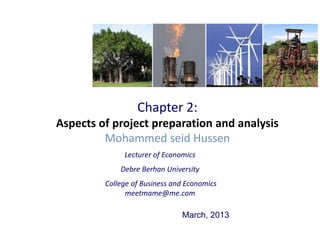
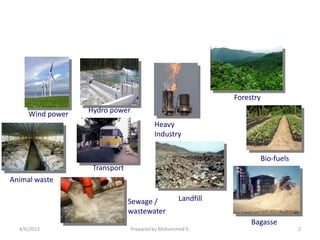
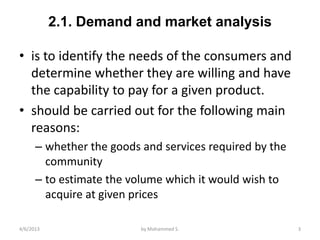
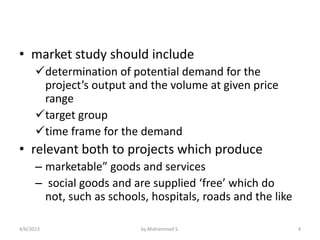
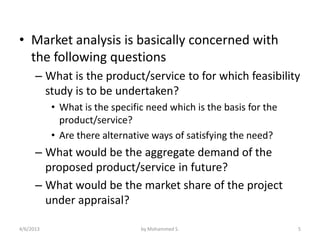

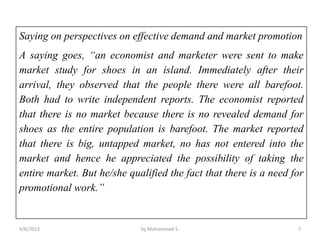
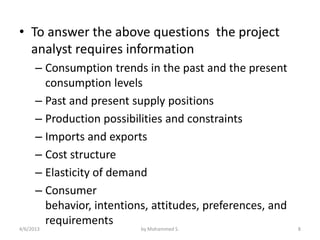
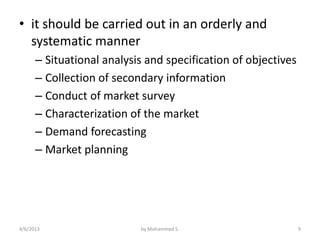
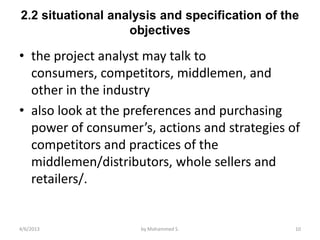
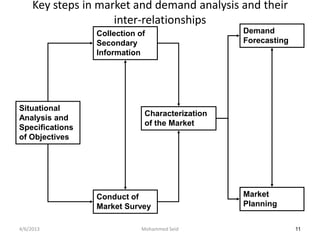
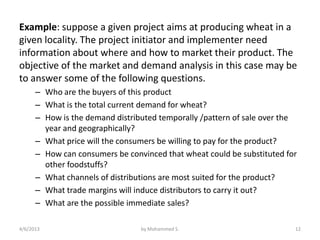
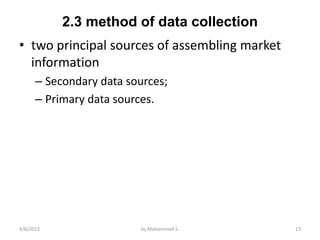
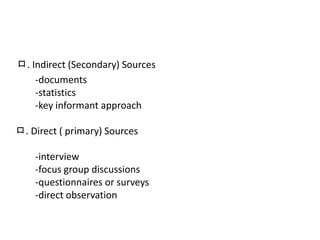
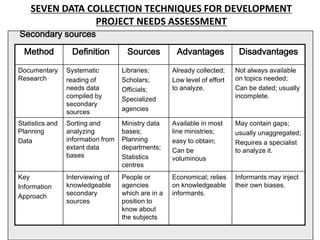


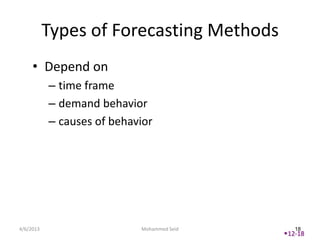
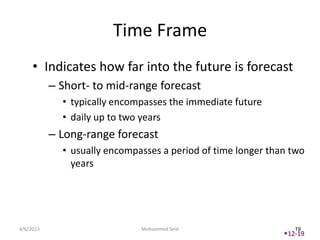
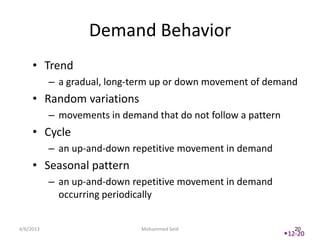
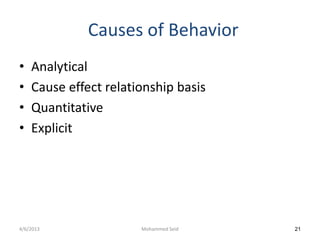
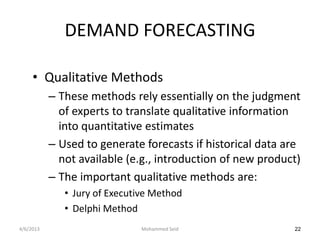
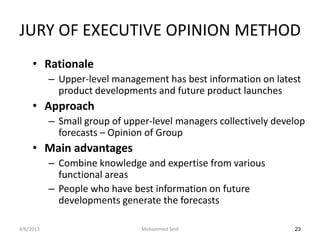
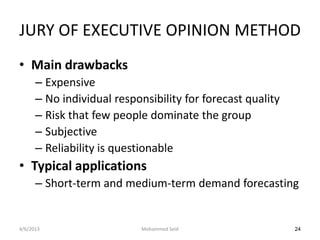
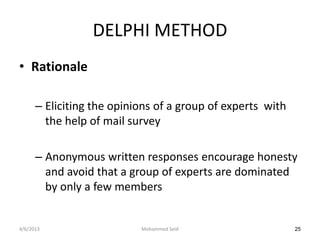
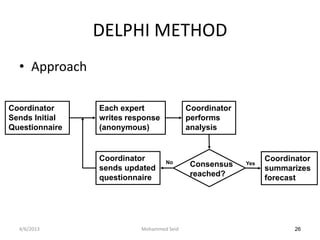
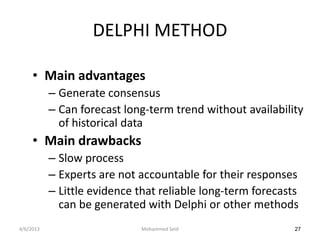

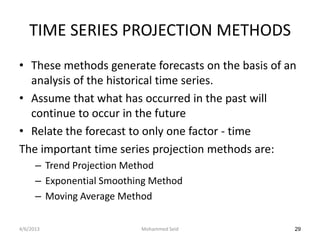
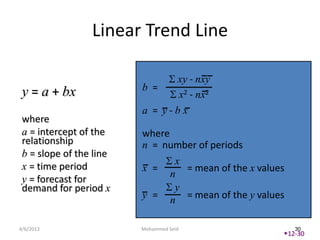
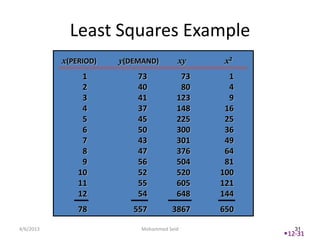
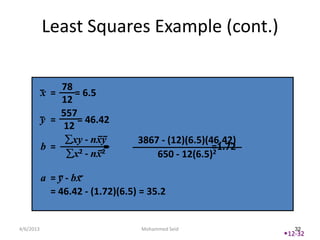
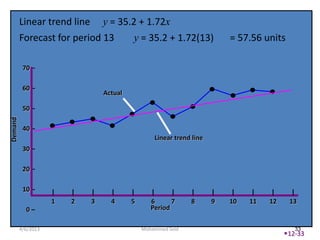
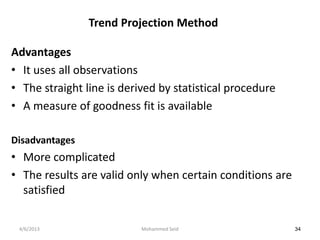

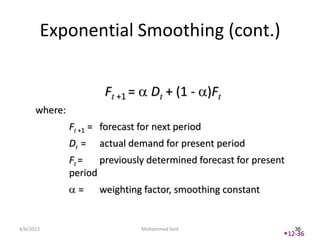
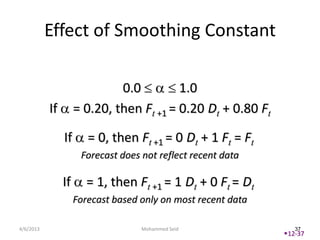
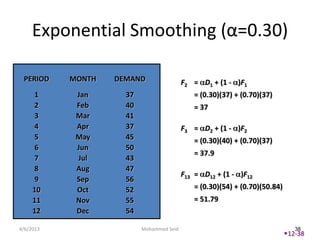
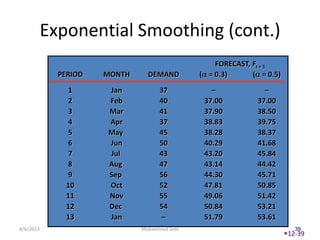
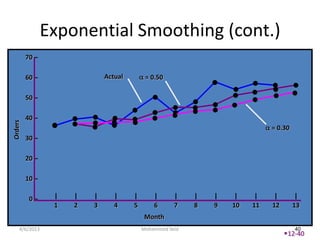
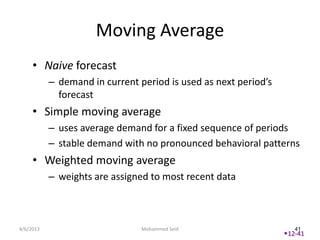
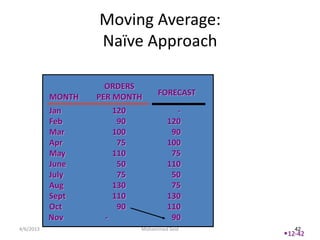

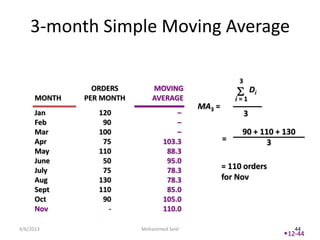
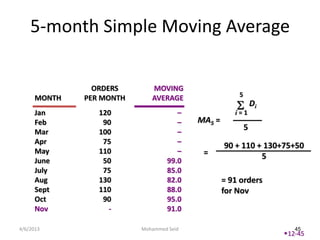
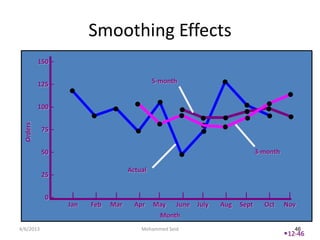
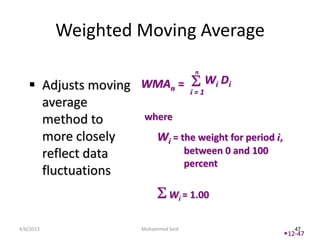
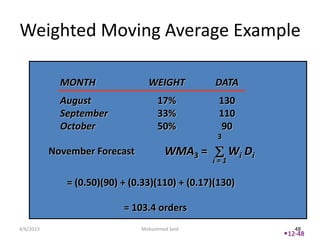

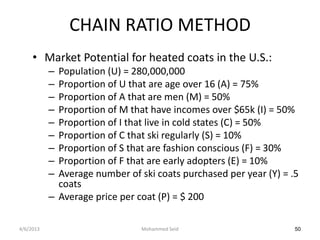
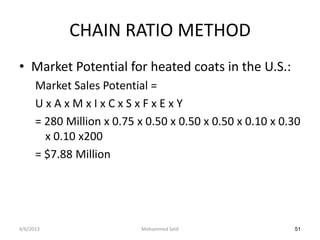
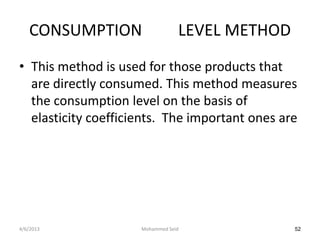
![CONSUMPTION LEVEL METHOD
ÔÇó Income Elasticity: This reflects the responsiveness
of demand to variations in income. It is calculated
as:
ÔÇó E1 = [Q2 - Q1/ I2- I1] * [I1+I2/ Q2 +Q1]
ÔÇó Where E1 =
Income elasticity of demand
Q1 = quantity demanded in the base year
Q2 = quantity demanded in the following year
I1 = income level in the base year
I2 = income level in the following year
4/6/2013 Mohammed Seid 53](https://image.slidesharecdn.com/chapter2-130406023733-phpapp01/85/Aspect-of-development-project-prepation-53-320.jpg)
![CONSUMPTION LEVEL METHOD
ÔÇó Price Elasticity: This reflects the responsiveness of
demand to variations in price. It is calculated as:
ÔÇó EP = [Q2 - Q1/ P2- P1] * [P1+P2/ Q2 +Q1]
ÔÇó Where EP = Price
elasticity of demand Q1 = quantity
demanded in the base year Q2 = quantity
demanded in the following year P1 = price level in
the base year
P2 = price level in the following year
4/6/2013 Mohammed Seid 54](https://image.slidesharecdn.com/chapter2-130406023733-phpapp01/85/Aspect-of-development-project-prepation-54-320.jpg)
